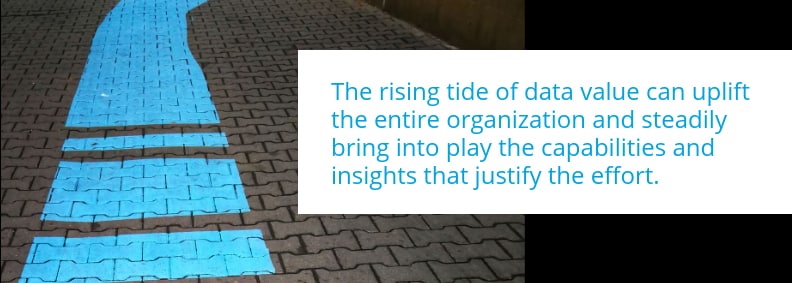Transforming for value – Data as a strategic asset
Data is often viewed as a costly necessity and a byproduct by many organizations. To be sure, it’s required to operate effectively. Sometimes, it can even seem more like an expensive headache than useful. Innovative, leading organizations see things differently. They understand that data is a strategic asset.
An asset is one of several holdings that appreciates and generates a return. A strategic asset is among the most important things a company owns. When organizations approach data as a strategic asset, it can open the door to new efficiencies, insights, and capabilities while also enabling emerging technologies. Reaching the point of maturity where enterprise strategy and operations are data-driven can require a medley of phased actions executed with a transformative vision.
What is needed is a purposeful shift away from managing a mesh of siloed, inconsistent data to a position where data is fuel for accelerating growth and innovation, improving financial performance, and enhancing the enterprise culture. While it is no simple endeavor, there is a clear path forward.

The business trends toward data modernization are clear
In a 2021 Deloitte survey of CFOs, 85% reported a significant acceleration in digital transformation in the year ahead. In this, there are sure to be some common data challenges.
Modernizing data infrastructure
40% report "low" or "medium" level of sophistication across a range of data priorities
Digital transformation
Report a significant acceleration in digital transformation in the year ahead
A phased approach with value at each stage
The capacity to use data as a strategic asset typically emerges through a continuum of steps. Each step offers independent value, and the incremental benefits can compound throughout the endeavor. Particularly in large organizations, the areas of activity may occur concurrently or start or stop as different divisions reach new plateaus in data maturity. Throughout, however, the rising tide of data value can uplift the entire organization and steadily bring into play the capabilities and insights that justify the effort.
While this journey tends to be iterative and incremental, it is often composed of four phases: foundation, productization, monetization, and strategic application.

Laying the foundation
Businesses often rely on a mix of legacy technologies, bespoke applications, and modern as-a-service offerings. This can lead to a technical workforce that spends more time operating and maintaining a complex patchwork of technologies than in valuable activities involving data-driven innovation. The groundwork for using data as a strategic asset is building consensus for change in processes, technologies, and the people who employ them.
As a starting point, leading enterprises identify priorities in both processes and technology. They set clear processes for data governance, compliance, and security, and they develop a common taxonomy, data access controls, and standard processes and data schema. Many leading organizations also explore new platforms that support data ingestion, curation, standardization, and distribution. They also consider a robust, increasingly cloud-based, data management platform with data lakes and warehouses. Progress toward these outcomes often requires change drivers—individuals empowered to identify use cases, gain leadership buy-in, embed data controls into processes, and forge a future-oriented talent strategy.
Collectively, this can spur data readiness and a modernized approach to handling data across the value chain. These preliminary steps deliver trustworthy, higher quality data that are searchable and accessible by all stakeholders, evidencing early ROI. Meanwhile, designing for scalability sets the stage for unlocking more value as the journey progresses.

Moving to production
Data can increase in value the more it is easily accessible and the more that it is used, and since many people do not have (nor need) analytics or data tools background, data should be made consumable. Productizing data represents a shift toward packaging data for known and potential use, creating data services built to support known use cases as well as those that have not yet been imagined.
Enabling access relies on a unified, harmonized ecosystem of platforms, along with APIs delivering a consistent, digestible view of the data to all stakeholders. As essential as it is to address these technologies, it can be equally important to address people. Set aside the antiquated thinking that “all things data” are owned by IT. Rather, there are essential stakeholders throughout the organization. The task is to assign data owners, empower data governance, and rally the entire workforce behind data training and new ways of working. Through this, the organization is advancing toward enterprise-wide scale.
When curated, versioned, governed, multiuse data are shared across an organization, stakeholders can find their place in the data ecosystem. The data is held and presented with the end-user in mind, such that they can find the right data, have the capacity to analyze it, and can discover meaningful insights that advance their work and improve their decision making.
Enabling data monetization
A data-driven enterprise can be positioned to monetize its data in multiple ways. While this might include direct revenue in the form of data assets sold to relevant third-parties (in line with appropriate regulations), the deeper value can emerge in the form of data packages and combinations that advance the business and generate a financial return. Used as a strategic asset, data has equity as the cost of storing and managing it is exceeded by the value realized through applications throughout the business. Better-targeted marketing campaigns typically drive more interest and sales. Supply chain management relies on real-time data for proactive decision making, driving efficiency and assurance of supply. Sales data informs product innovation, enhancing competitiveness and revenue in the marketplace.
Reaching this state typically requires supplementary activities. Business units can thrive with data stewards who are responsible for their division’s data generation, curation, and productization. This empowers individuals who respond to changing environmental and market realities by turning to the data in search of competitive insights and opportunities. They also employ standard analytical toolsets that push information to business customers. Throughout this phase, data fluency is increased to enhance understanding of both potential value and risks.
These efforts align platforms, people, and processes for scale, helping position the organization to begin applying an ecosystem of emerging capabilities and tools, such as AI and advanced analytics.

Leveraging data as a strategic asset
The important changes and activities in prior phases move the organization toward data-centric operation. Systems and processes are oriented for fast, reliable access to curated data. Employees are educated and fluent in data and use it for decision making. High-quality data enables the use of artificial intelligence (e.g., visual analysis, natural language processing, predictive analytics) to further automate complex processes, glean unique and predictive insights, make machine engagement more human, craft new products, services, and even entirely new business models, and enhance brand trust.
In the sustainable future state, transformed organizations use data to drive toward enterprise goals, enhanced productivity, and greater profitability. The business contributes to and draws from third-party data ecosystems, combining proprietary datasets with the vast data oceans available from every segment of the connected world. The data-driven enterprise tracks how data is used, analyzed, and managed. It builds on use cases for new solutions and thrives on automated insights that support efficiency, decision-making, rapid prototyping, innovation, streamlined manufacturing, and more. As each use case is identified and value is captured, the justification for the journey to data as a strategic asset becomes clear.

Continuing the journey
All organizations are at different places along the data maturity curve. Some are clear leaders seizing new ground with AI, but many are still working out the truest path forward. With the above vision for phasing into data maturity, next steps become clearer. As you evaluate your enterprise, consider some guidelines for moving beyond the foundational efforts to capture more value from your data.
Reaching a place where the deeper value of data is accessible should not take forever, and there is some urgency. Many companies are now realizing just how much potential value can be extracted for every component of the organization from an asset they already hold. Those that recognize it can seize a competitive advantage and move quickly to transform their workforce, processes, and technology ecosystem to generate maximum return for the enterprise.
Download the REPORT

High-quality data enables the use of cognitive tools under the AI umbrella permitting new products, services, and even entirely new business models.



